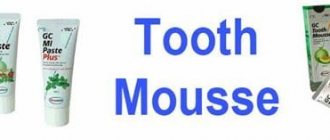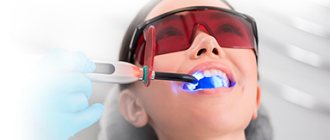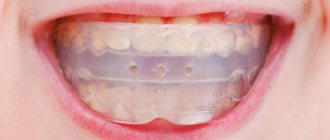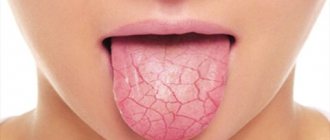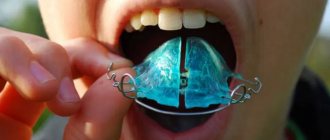Why carry out enamel restoration?
The human mouth contains a huge number of different bacteria, both beneficial and harmful. If their number is balanced, inflammatory processes do not develop. But under the influence of external factors, for example, with a decrease in immunity, the accumulation of a large amount of plaque and stone, exacerbation of chronic diseases, the number of pathogenic bacteria increases sharply. And first of all, they attack tooth enamel. Gradually it is destroyed, as a result of which inflammatory processes penetrate inside - affecting the dentin, and then the nerve. That is why tooth enamel requires protection, strengthening and saturation with minerals.
Scientists were able to calculate and determine in numbers the weight of microorganisms that inhabit our body - they are about 2 kilograms, and this is almost 10 thousand types of microorganisms. At the same time, about 700 types are represented in the oral cavity. In quantitative terms, this is 40 thousand different bacteria1.
In addition, it is very important to have regular professional cleanings - not only to remove plaque and tartar from the surface of the teeth, from between teeth and from under the gums, but also to polish the enamel. This will rid the shell of the teeth of micropores, which also often become clogged with tiny bacteria, attacking the tooth literally from the inside.
Signs
Signs of demineralization are difficult to detect on your own. They are often diagnosed by a doctor during a routine examination at a dental clinic. The first sign of pathology is the appearance of white areas on the surface of the teeth. They appear in the form of dots, spots, stripes. The type of enamel changes. She's losing her shine. This is noticeable when the surface dries. As the process progresses, the affected areas become rough and increase in size. The next stage is the development of caries.
Increased tooth sensitivity is associated with changes in the characteristics of the enamel. It becomes thinner, so cold, hot, sour, sweet foods cause sharp short-term pain.
Benefits of Apadent Pro paste
Apadent Pro paste (Apadent Pro) is intended for professional use. It contains hydroxyapatite nanoparticles, which are so small in size that they can easily penetrate the micropores of the hard shell of teeth, qualitatively improving its mineral composition and restoring its structure. The substance evens out the surface of the teeth and makes it smooth. Thanks to this, bacteria and plaque are much less likely to penetrate inside the tooth and lead to tissue inflammation.
Hydroxyapatite is a mineral that is the main constituent of our bones. Preparations based on it make it possible to regulate the ratio of calcium and phosphorus in the body. It is biocompatible and promotes the restoration of bone tissue, including tooth enamel.
What are the advantages of using paste:
- restoration of the integrity and structure of tooth enamel,
- restoration of the mineral composition of enamel,
- increased resistance of teeth to bacteria, reduced risk of caries,
- reduction of discomfort from temperature stimuli,
- strengthening dental health,
- long-term preservation of the results of professional whitening,
- rapid achievement of high treatment results.
Remineralizing therapy using Tooth Mousse and MI Paste Plus (GC)
The problem of such a common disease as dental caries occupies one of the leading places in therapeutic dentistry [8]. Today, the arsenal of remineralizing therapy products is diverse both in composition and in methods of application. To introduce active components into tooth tissue, the following are used: applications, rinses, gels, varnishes, pastes, films, electrophoresis and phonophoresis, etc.
The chemical composition and direction of the preventive effects of these agents are determined by the processes occurring in the area of carious lesions. The main goal of the pathogenetic effect is to restore the composition and structure of the main mineral component of the enamel. This is achieved in several ways: by creating conditions for the recrystallization of hydroxyapatite or by growing its analogs with lower solubility [5–7].
Fluorapatite has greater dynamic stability than hydroxyapatite, which determines its greater resistance. The formation of fluorapatite from hydroxyapatite occurs at a certain ratio of calcium and phosphorus in the mineralizing solution and at low fluorine concentrations [1, 3, 10, 12]. Selecting the optimal ratio of active components in mineralizing solutions is a very difficult task. You can alleviate it by using natural mineralized products. Thus, the well-known bone tissue hydrolyzer “Remodent” [11] was proposed as a remineralizing agent, which has proven itself to be an excellent remineralizing drug.
With that said, our focus has been on selecting natural mineralizing products. Of the variety of modern products, we were interested in the bioavailable remineralizing preparations Tooth Mousse and MI Paste Plus (GC Corporation, Japan).
Tooth Mousse
Tooth Mousse (GC Corporation, Japan) - “Mousse for teeth”, or “Liquid enamel”. The active component of “liquid enamel” is Recaldent®, containing the CPP-ACP complex (casein phosphopeptide - amorphous calcium phosphate). CPP-ACP was developed by the School of Dental Science, University of Melbourne Victoria/Australia (Recaldent® used under license from Recaldent® Pty. Limited).
The CPP-ACP complex is produced from casein in milk. Milk casein is a carrier of active ingredients and binds freely to enamel, biofilm, plaque and soft tissue, delivering calcium and phosphate where they are most needed. Amorphous calcium phosphate complex is a perfectly balanced combination that is identical to the lost components of tooth enamel and provides tooth enamel with free calcium and phosphate ions.
Mousse for teeth is an application preparation for restoring mineral balance in the oral cavity and remineralization. It is used to reduce the sensitivity of dental tissues after whitening, professional cleaning, curettage, orthodontic treatment, prevention of caries in the early stages and to normalize salivation.
MI Paste Plus
MI Paste Plus (GC Corporation, Japan) is a water-based cream containing Recaldent® with the addition of CPP-ACPF fluoride: casein phosphopeptide - amorphous calcium phosphate fluoride. The fluoride level is 0.2% (900ppm), which is approximately the same as the concentration found in adult toothpastes. In the oral cavity, CPP-ACPF molecules bind to biofilm, dental plaque, hydroxyapatite crystals of dental enamel and settle on soft tissues, localizing bioavailable calcium, phosphate and fluoride.
PURPOSE OF THE STUDY
To study the remineralizing effectiveness of Tooth Mousse and MI Paste Plus cream.
MATERIALS AND METHODS
The effect of the drugs was studied by assessing the effectiveness of remineralizing therapy performed on patients of the dental department of the Rostov State Medical University clinic. A total of 16 patients, students of Rostov State Medical University, who applied for oral sanitation, participated in the clinical observation.
The average age of the patients was 23±2.0 years. All applicants required sanitation of the oral cavity; 5 people complained of enamel hyperesthesia; in 11 of those observed, foci of initial dental caries were identified. The scope of clinical dental examinations and treatments included: a survey, an external examination, an assessment of oral hygiene and hard dental tissues. The assessment of the condition of the teeth included the indexes of dental caries intensity (DCI) and CSI of cavities (CPUp). Initial caries was determined by counting and staining demineralized spots.
The oral cavity examination began with identifying complaints and collecting anamnesis. Oral hygiene was assessed using the Yu. A. Fedorov - V. V. Volodkina index.
The processes of remineralization of tooth enamel were assessed using the enamel resistance test (ERT) and the mineralizing potential of saliva (MP).
The scope of clinical dental examinations and treatments included: a survey, an external examination, an assessment of oral hygiene and hard dental tissues. The assessment of the condition of the teeth included the indices KPUz and KPUp TER test (V.R. Okushko and L.I. Kosareva) evaluates the resistance of tooth enamel to the action of acids [10, 12]. Methodology: the central incisor of the upper jaw was cleaned of soft plaque with a solution of hydrogen peroxide, dried with a cotton swab and isolated from saliva. To the middle of the vestibular surface of the tooth for 5 seconds. etchant acid with a diameter of 2-3 mm was applied. The etched area was then stained with a 1% aqueous solution of methylene blue. Using abrasive movements, the dye was removed with a dry cotton swab, carefully pressing it to the surface of the tooth. The dye is completely removed from the unetched enamel surface, leaving the etched area colored.
To assess the intensity of coloring, a 10-field typographic blue scale was used from 10 to 100% color intensity. With a staining intensity of 30%, tooth enamel is resistant to acidic factors; with staining from 30 to 60%, tooth enamel is moderately resistant to acids; with an intensity of 60 to 100%, tooth enamel is unstable to acids.
The mineralizing potential of saliva (P. A. Leus) gives an idea of the saturation of oral fluid with microelements [4, 12]. Method: 3 drops of saliva were applied to a glass slide using a pipette and dried at a temperature of 37 C. The preparations were examined under a microscope at low magnification.
The type of microcrystallization of oral fluid was determined. The first type of microcrystallization corresponded to saliva saturated with microelements and represented elongated, prismatic crystal structures, often with a radial orientation. The second type corresponded to the average level of saliva saturation with calcium and other elements and looked like isometrically located fragments of crystals, without a clear orientation. The third type corresponded to saliva poor in microelements - scattered small single unoriented fragments of crystals.
The severity of demineralization processes was studied by the degree of activity of foci of initial dental caries (L. A. Aksamit). The intensity of foci of demineralization—white carious spots—was assessed using the vital staining method [2]. The teeth to be examined were carefully isolated from saliva, and a cotton swab generously moistened with a 2% solution of methylene blue was applied to the carious stain.
After using Tooth Mousse and MI Paste Plus, the enamel became more resistant to acids and more resistant to cariogenic factors. After 3 minutes, the tampon was removed, the excess dye was washed off with water. To assess the intensity of staining, a standard color scale was used, providing various shades of blue from slightly bluish to dark blue. The results obtained were assessed in points (from 1 to 10 points). When the intensity of staining of the foci is up to 3 points, the activity of demineralization is low, from 3 to 6 points - the activity is of medium degree, from 6 to 10 points - the activity of demineralization foci is high.
During clinical observation, all patients underwent professional oral hygiene and personal hygiene correction. After sanitation of the oral cavity, the studied remineralization agents were prescribed. The observed patients used “liquid enamel” in addition to their usual toothpastes. Tooth Mousse and MI Paste Plus cream were applied to the teeth after brushing every day, before bed, for a month. The effectiveness of remineralizing therapy was assessed immediately after monthly therapy and over time after 6 months. Of the observed patients, 11 people used Tooth Mousse and 5 people used MI Paste Plus cream.
Research results
Below are the results of using the remineralizing therapy drugs Tooth Mousse and MI Plus (GC Corporation, Japan).
An assessment of the condition of the teeth using the indices of the CPU of teeth and CPU of cavities showed that the values of these indices are quite high and remineralization therapy is indicated for all observed patients. Thus, the CPU index of teeth had a value of 9.1 ± 0.8, and the CPU index of cavities was 10.7 ± 1.0. Initial dental caries was registered in 68.8% of patients who applied for oral cavity sanitation. The average number of initial caries was 1.6 ± 03, i.e., on average, 1-2 foci of initial caries were recorded in each patient, and the intensity of demineralization of the identified foci corresponded to 5.3 ± 0.9 points, which indicates the active course of the initial dental caries.
During the period of use of Tooth Mousse and MI Paste Plus cream, all indicators of the processes of de- and remineralization in the oral cavity changed. Analysis of the state of oral hygiene of the examined patients showed that as a result of the correction of hygienic skills and therapeutic and preventive measures, the level of hygiene improved and the indicators of hygiene indices ( GI) decreased during the observation period. So, if initially the GI had a value of 1.8 - 0.3 points, which corresponds to a satisfactory level of hygiene, after a month the GI was rated as “good” and had a value of 1.4 - 0.1 points.
The effectiveness of remineralizing therapy of the studied drugs was assessed immediately after a monthly course of applications. During the period of using Tooth Mousse and MI Paste Plus cream, all indicators of de- and remineralization processes in the oral cavity changed. These indicators in the groups of patients using only Tooth Mousse or only MI Paste Plus had comparable changes, so the evaluation of the effectiveness of the drugs was carried out in the general group of patients and was not divided by the drugs used (Table No. 1).
Table No. 1. Indicators of de- and remineralization processes in the oral cavity during the use of Tooth Mousse and MI Paste Plus cream (M±m).
Observation | Vital staining of foci of initial dental caries (points) | Enamel resistance test of the surface layer of tooth enamel (%) | Microcrystallization of a dried drop of oral fluid (type) |
| Before remineralizing therapy | 5,3 ±0,9 | 50,0 ±3,4 | III type |
| After remineralizing therapy | 1,4 ±0,4 | 36,9±1,9 | Type I |
| R | < 0,05 | < 0,05 | < 0,05 |
Thus, the activity indicators of initial caries in all observed patients decreased. The intensity of demineralization foci decreased by 3.8 times. Thus, before retherapy, the activity of carious lesions corresponded to a value of 5.3 ± 0.9 points, after therapy - 1.4 ± 0.4 points, with (p < 0.05).
Remineralization processes in the oral cavity have significantly improved. Analysis of indicators characterizing the resistance of tooth enamel to acids demonstrates that after using Tooth Mousse and MI Paste Plus, the condition of the surface layer of enamel became more resistant to acids, and the enamel became more resistant to cariogenic factors. Thus, according to the resistance test (TER), the indicators decreased from 50.0 ± 3.4% to 36.9 ± 1.9%.
Characteristics of the remineralizing properties of saliva showed that the oral fluid became more saturated with microelements (Table No. 1). The average indicators for saliva microcrystallization before treatment corresponded to type III - unformed crystals (2.8 - 0.1 points), after treatment - to type I - formed crystal lattice (1.3 - 0.2 points).
Dynamic monitoring of the effectiveness of remineralizing therapy showed that there was a significant preservation of indicators based on data characterizing the process of demineralization of tooth enamel and the mineralizing potential of saliva (Table No. 2).
Table No. 2. Indicators of dynamic monitoring of the effectiveness of remineralizing therapy when using Tooth Mousse and MI Paste Plus cream (M±m).
Observation | Vital staining of foci of initial dental caries (points) | Enamel resistance test of the surface layer of tooth enamel (%) | Microcrystallization of a dried drop of oral fluid (type) |
| Before remineralizing therapy | 5,3 ±0,9 | 50,0 ±3,4 | III type |
| 6 months after remineralizing therapy | 2,5 ±0,5 | 45,5±0,9 | Type II |
| R | < 0,05 | > 0,05 | < 0,05 |
Thus, after 6 months, the average activity indicators of initial caries foci were 2.5-0.5 points versus 5.3-0.9 points before treatment (p < 0.05).
Indicators of the mineralizing potential of saliva after 6 months corresponded, on average, to type II microcrystallization (1.8–0.2 points) compared to the initial type III microcrystallization (2.8–0.1 points), with (p < 0.05). In terms of indicators characterizing the processes of enamel resistance to acids, we did not identify any pronounced differences compared to the initial values. Thus, the acid resistance of enamel (AER) after 6 months corresponded to 45.5-0.9% and became comparable to the initial 50-3.4% (p > 0.05).
Also, an analysis of indicators over time demonstrated that MI Paste Plus cream (containing fluoride compounds) has more stable results for all studied indicators (Table No. 3, 4).
Table No. 3. Indicators of dynamic monitoring of the effectiveness of remineralizing therapy when using MI Paste Plus cream (M±m).
Observation | Vital staining of foci of initial dental caries (points) | Enamel resistance test of the surface layer of tooth enamel (%) | Microcrystallization of a dried drop of oral fluid (type) |
| Before remineralizing therapy | 5,3 ±0,9 | 50,0 ±3,4 | III type |
| 6 months after remineralizing therapy | 2,4 ±0,5 | 40,5±0,9 | Type I |
| R | < 0,05 | < 0,05 | < 0,05 |
Table No. 4. Indicators of dynamic monitoring of the effectiveness of remineralizing therapy when using Tooth Mousse (M±m).
Observation | Vital staining of foci of initial dental caries (points) | Enamel resistance test of the surface layer of tooth enamel (%) | Microcrystallization of a dried drop of oral fluid (type) |
| Before remineralizing therapy | 5,3 ±0,9 | 50,0 ±3,4 | III type |
| 6 months after remineralizing therapy | 2,5 ±0,5 | 45,5±0,9 | Type II |
| R | < 0,05 | > 0,05 | < 0,05 |
Analysis of the data on the demineralization process showed that after 6 months in the group of patients who used MI Plus cream, stable stabilization of the demineralization process of tooth enamel remained (2.4-0.5 points versus 5.3-0.9 points before treatment).
According to the enamel acid resistance test (ERT), the 6-month follow-up indicators in this group had comparable differences with the data before treatment (40.0 - 2.8% and 50.0 ± 3.4%). Indicators of mineral saturation of oral fluid in the group using MI Plus cream after 6 months continued to correspond to the high mineralizing potential of saliva (1.2-0.2 points with 2.8-1.2 points before treatment).
Thus, the remineralizing products Tooth Mousse and MI Paste Plus:
- have a regulatory effect on the processes of de- and remineralization in the oral cavity;
- stabilize demineralization processes (the activity of initial caries is suspended);
- normalize the saturation of oral fluid with microelements;
- increase the resistance of the surface layer of tooth enamel to cariogenic factors.
The most effective in our observation was a product containing fluoride compounds: MI Paste Plus cream.
CONCLUSION
Remineralizing preparations Tooth Mousse and MI Paste Plus (GC Corporation, Japan) are effective means for regulating the processes of de- and remineralization of hard dental tissues.
LITERATURE
- Avramov O. G. Processes of remineralization and permeability of tooth enamel during oral hygiene / O. G. Avramov // Proceedings of the Fifth Congress of the Russian Dental Association. - M., 1999. - P. 39.
- Aksamit L. A. Diagnosis of the initial stage of enamel demineralization using the staining method. - M. 1973. - P. 4-5.
- Borovsky E. V. Biology of the oral cavity / V. E. Borovsky, V. K. Leontiev. - M.: Medicine, 2001. - 304 p.
- Denisov A. B. Diagnostic informativeness of saliva. Research prospects / A. B. Denisov // Dental Review. Education, science and practice in dentistry: Abstracts of reports of the All-Russian Dental Forum. - M., 2004. - P. 253-256.
- Knappvost A. The influence of fluoride ions on the physiological and pathological metabolism of calcium: caries, osteoporosis, atherosclerosis (Hamburg) / A. Knappvost // Maestro. - 2000, No. 1. - P. 57-60.
- Kolesnik A.G. Chemical means for the prevention of dental caries / A.G. Kolesnik, T.L. Pilat // Dentistry. - 1989, No. 1. - P. 86-89.
- Kolpakov V.V. Physiological bases of prevention of dental diseases / V.V. Kolpakov, A.V. Bragin, A.L. Ivanova, A.V. Starikova // Materials of the IX and XI All-Russian Scientific and Practical Conferences and Proceedings of the VIII Congress of Dental Medicine Association of Russia. - M., 2003. - P. 313-315.
A complete list of references is in the editorial office.
Indications for use
This paste is prescribed to patients with increased sensitivity of the enamel, in the presence of superficial caries and foci of demineralization. It is also used as a preventive measure for many dental diseases along with comprehensive oral hygiene. The composition is completely safe for both adults and small children, even if a child swallows it, nothing will happen, because the paste contains no dyes or toxic substances.
Strengthening the enamel is also indicated before and after teeth whitening - the procedure will restore the mineral composition of the enamel and reduce sensitivity after aggressive exposure. In addition, the procedure using the paste will prolong the effect for at least six months.
The paste will also be an excellent solution for patients who wear aligners to correct their bite or are preparing to install/remove braces.
Contraindications
The procedure is non-invasive and safe, but not everyone can do it. Individual intolerance to the components of drugs that are used to restore the balance of minerals is possible. If there is a history of hypersensitivity reactions, enamel restoration agents should be used with caution.
For some diseases, such as hormonal disorders and kidney diseases, the use of fluoride-containing drugs is contraindicated. If you have chronic problems, be sure to tell your dentist about it.
How is enamel strengthened?
Apadent paste with the Pro prefix is intended specifically for professional use, that is, in the dentist’s office. As a rule, it is combined with comprehensive hygiene. Both procedures take about 30-60 minutes and are carried out as follows:
- applying superficial anesthesia if necessary,
- removal of plaque and stone using ultrasound, Air Flow,
- polishing tooth enamel using a brush and regular paste without adding abrasive particles,
- applying Apadent Pro composition to the enamel, brushing each tooth for 15-20 seconds for better penetration of the active substance,
- Keep the paste on the teeth for 2-3 minutes, after which it is washed off.
As a rule, with minor demineralization, one application will be sufficient. For more pronounced pathologies, it is better to carry out the enamel strengthening procedure in a course that consists of at least 3 repetitions. This can be done both in dentistry and at home - for this the patient will need to have individual mouth guards made.
The strengthening of Apadent Pro in general has practically no restrictions - it is suitable for both children and adults. If you monitor the condition of your teeth, treat all diseases in a timely manner and do not forget about comprehensive hygiene, this paste will be an excellent assistant in maintaining the health of your entire oral cavity. But, naturally, this procedure should be carried out on a regular basis - 1-2 times a year will be enough for prevention.
Causes of tooth demineralization
Tooth enamel is destroyed for a number of reasons. Most often, a violation of the mineral composition is provoked by the following factors:
- Excessive consumption of sugar and sweets;
- Alcohol abuse, addiction to coffee and tea;
- Failure to adhere to proper nutrition;
- Drinking unfiltered or low-quality water;
- Lack of vitamins in the body;
- Constant stress.
The listed factors change the pH of saliva, which provokes demineralization. It is no secret that saliva is the main source of minerals for tooth enamel. Therefore, any imbalance in this environment leads to negative consequences. A lack of calcium, fluoride and other nutrients appears as white spots on the enamel. This is the first sign of demineralization.
Apadent series for home use
The Japanese manufacturers of Apadent Pro paste have made sure that people of all age groups can benefit from medical hydroxyapatite. They included it in both professional dental pastes and self-care products for the oral cavity. They can be used at home in combination with office procedures.
There is a whole line of Apadent products:
- Apadent Total Care: effectively restores demineralized enamel, covers dentinal tubules, fights early caries,
- Apadent Sensitive: this paste is suitable for those with sensitive teeth. Effectively fights plaque, evens out and fills microscopic cracks in enamel,
- Apadent Perio: paste to reduce bleeding gums and relieve inflammation. In addition to the usual nano-hydroxyapatite, the composition also contains ocean salt,
- Apadent Kids: a toothpaste that has been specially developed for babies. It also contains nano-hydroxyapatite. It does not contain fluorine, parabens, dyes or sodium lauryl sulfate, so it is as safe as possible for both young children and teenagers.
These pastes are quite expensive - from a thousand rubles and more. Therefore, whether to use them or not at home is the decision of each individual person, which should be influenced by the condition of the teeth. We recommend that you undergo the remineralization procedure at the dentist, after which the doctor will be able to give recommendations on the advisability of using such drugs at home.
